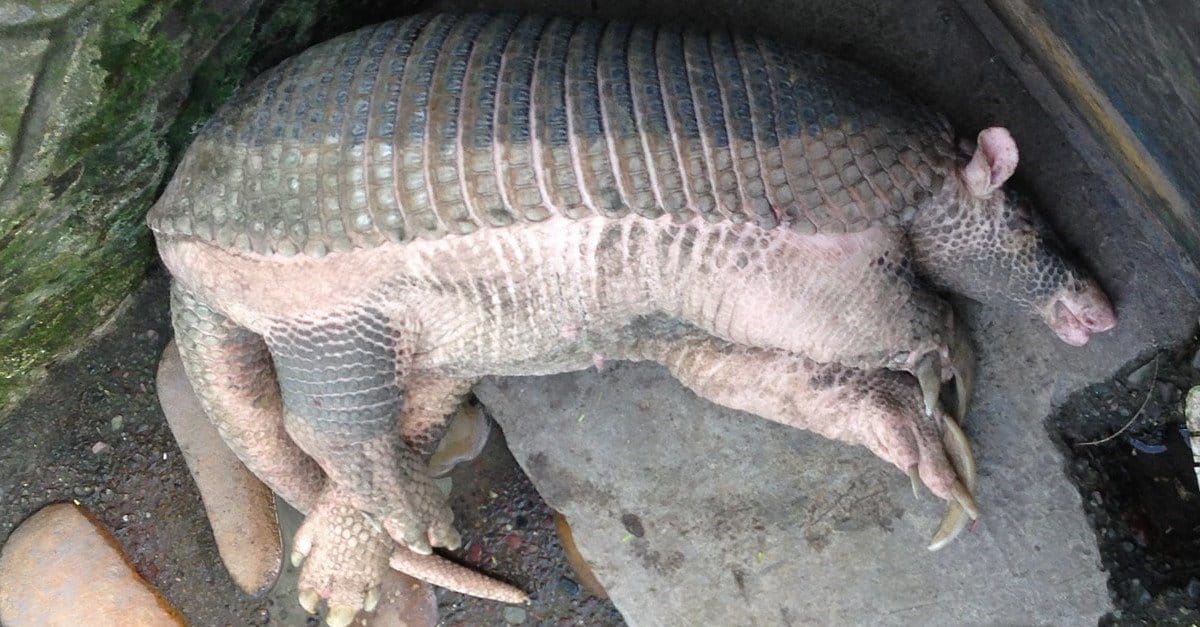

These animals are capable of balancing on their hind legs and tail, allowign them to reach high into termite mounds (this technique also comes in handy for warding off predators). They dig large burrows in which they rest, using their spade-like third claws. These armadillos forage alone, only assosciating with others to mate. Priodontes maximus is largely nocturnal and terrestrial. Status: captivity 4.0 years Max Planck Institute for Demographic Research The lifespan of these animals can reach 12 to 15 years. The role of the male in parental care has not been documented for P. Afterwards, the young stay with the mother until they reach independence at around 6 months of age. Mothers stay with the young and nurse them for 4 to 6 weeks. Little is known about parental care in giant armadillos. Range age at sexual or reproductive maturity (male) 9 to 12 months.Range age at sexual or reproductive maturity (female) 9 to 12 months.Range time to independence 4 to 6 months.Average gestation period 122 days AnAge.Breeding season It is not known whether these animals breed seasonally.


Armadillos reach sexual maturity within 9 to 12 months of birth. Weaning begins about 4 to 6 weeks after birth, and after weaning, the young become independent. They typically give birth to a single offspring (occasionally two), which weigh up to 113 g at birth, and already possess tough skin. Very little is known about the reproductive behavior of giant armadillos. Considering the habits of other armadillos, however, one may infer that two giant armadillos pair for each breeding season while sharing a burrow. Very little information is available on the mating habits of South American armadillos. Average basal metabolic rate 16.892 W AnAge.( Eisenberg and Redford, 1999 Emmons, 1997) The head is conical, with a blunt rostrum. The legs and tail are covered with tough pentagonal scales. Underneath the carapace, the naked body appears wrinkly and pinkish. The dorsal portion of this carapace appears black/gray, while the ventral portions of the carapace are much lighter and separated by a noticeable band. Typical of armadillos, Priodontes maximus has a carapace covered with bony scales. Another recognizable characteristic is its enlarged central claw, much like that of giant anteaters, Myrmecophaga tridactyla. In most cases, it weighs upwards of 26 kg, and measures between 832 and 960 mm. Priodontes maximus is easily distinguished from other armadillos due to its enormous size. In these areas, the armadillos have been found residing up to 500 meters above sea level. Although rare, they have been sighted in tropical and subtropical rainforest, savanna, Brazilian floodplains, and arid and semiarid woodlands. Priodontes maximus is typically found in a diverse range of habitats, usually in areas with a large termite population. ( Eisenberg and Redford, 1999 Parera, 2002) Most of this species' range lies within the Amazon basin. They are found from southeastern Venezuela and the Guianas in the north through northeastern Brazil, Paraguay, and the extreme north of Argentina. In French Guiana it is fully protected by law.Giant armadillos, Priodontes maximus, range through much of the neotropics. It is listed as endangered in Colombia, Venezuela, Argentina, and Paraguay and considered Vulnerable in Bolivia, Peru, Ecuador, and Brazil. Priodontes maximus is included in Appendix I of the Convention on International Trade in Endangered Species of Wild Fauna and Flora (CITES) and on the international list of endangered species under the United States Endangered Species Act. These threats have led to an estimated population decline of at least 30% in the past three generations (which corresponds to around 21 years), and the species has disappeared from large parts of its southern range. Furthermore, it is sometimes captured to be kept as a pet or to be illegally sold as a “living fossil”, but it usually does not survive long in captivity. The species is hunted for meat and is heavily affected by habitat loss. Priodontes maximus has a wide area of distribution, but it is rare over its entire range and is very patchily distributed.


 0 kommentar(er)
0 kommentar(er)
